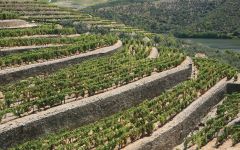Croft Fine Ruby
-
Wine
Spectator




Product Details
Your Rating
Somm Note
Winemaker Notes
A blend of young wines, matured in cask for an average of three years before bottling. Croft Fine Ruby is a crisp, full bodied and fruity Port rich in style and with a full deep red, intense appearance.
Professional Ratings
-
Wine Spectator
Well-balanced, powerful and fruity, with dark plum, red berry and spiced cherry flavors that feature plenty of smoke and spice. Notes of black licorice mark the finish. A suave ruby. Drink now through 2020. 2,000 cases imported.









The House of Croft, founded in 1678, was one of the earliest shippers of Port wines and since the seventeenth century, has been renowned for the excellence of its production.The family first became involved in wine shipping through their connection with a distinguished family of merchants, the Thompsons of York. The Thompsons had been trading with Portugal since 1660 and when Thomas Croft married Frances, daughter of Sir Stephen Thompson, it was only natural that the two families should combine their business interests in the wine trade.
Near river, rail and road transport and lying against a backdrop of rugged mountainous scenery, Roêda is considered to be the finest Port estate in Portugal. And today, it is from its own famous Quinta da Roêda, in the centre of the Douro valley, that Croft annually sends down to its lodges in Vila Nova de Gaia the fine wines that constitute the best of Croft's production.The twentieth century directors and managers of Croft & Co. have assiduously pursued the fine quality and reputation they inherited. The House of Croft has continued to play a dominant role in the development of the Port trade, both in Portugal and internationally.

Port is a sweet, fortified wine with numerous styles: Ruby, Tawny, Vintage, Late Bottled Vintage (LBV), White, Colheita, and a few unusual others. It is blended from from the most important red grapes of the Douro Valley, based primarily on Touriga Nacional with over 80 other varieties approved for use. Most Ports are best served slightly chilled at around 55-65°F.

The home of Port—perhaps the most internationally acclaimed beverage—the Douro region of Portugal is one of the world’s oldest delimited wine regions, established in 1756. The vineyards of the Douro, set on the slopes surrounding the Douro River (known as the Duero in Spain), are incredibly steep, necessitating the use of terracing and thus, manual vineyard management as well as harvesting. The Douro's best sites, rare outcroppings of Cambrian schist, are reserved for vineyards that yield high quality Port.
While more than 100 indigenous varieties are approved for wine production in the Douro, there are five primary grapes that make up most Port and the region's excellent, though less known, red table wines. Touriga Nacional is the finest of these, prized for its deep color, tannins and floral aromatics. Tinta Roriz (Spain's Tempranillo) adds bright acidity and red fruit flavors. Touriga Franca shows great persistence of fruit and Tinta Barroca helps round out the blend with its supple texture. Tinta Cão, a fine but low-yielding variety, is now rarely planted but still highly valued for its ability to produce excellent, complex wines.
White wines, generally crisp, mineral-driven blends of Arinto, Viosinho, Gouveio, Malvasia Fina and an assortment of other rare but local varieties, are produced in small quantities but worth noting.
With hot summers and cool, wet winters, the Duoro has a maritime climate.
